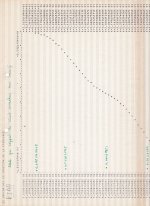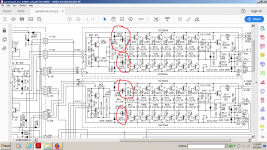🙂 There were still punched cards ?No, I was the computer operator. IBM 7094, 1401, 1620 from 1963-1967 '-) It would be interesting do be shown the development methods for IC's as it has changed over the decades. Still, IC's are limited by their power dissipation no matter what.
I just asked a question."Friendly exchange" == Give Me What I Want With No Payback. Strange way to conduct yourself on a forum.
Welcome in ...
🙂 There were still punched cards ?
We used them at the University of Illinois with the IBM 360 in 1970.
Speaking of Dave Wilson (RIP), here's his take on speaker placement.
Thanks for that. It was interesting to watch and listen. As mentioned the Zone of Neutrality is very important. Everything else seems pretty subjective, though if you are trained in the Wilson way then it might be easy.
If you are able to buy Wilson speakers from a Wilson dealer, they supposedly deliver them and set them up for you. I don't know of another speaker manufacturer that does that.
I think anyone trying to do this Wilson procedure on their own would find it hard to do, though it should work with any speaker in any room.
Yes T, big rooms with punched cards. I used to punch my own cards in later years, to do circuit design with ECAP, forerunner to SPICE. Sure beat a slide rule! '-)
And, today, smartphones with GB SD Cards...Yes T, big rooms with punched cards.
Oh, lord, what if miniaturization continues to progress at this rate ?
BTW, slide rule had an advantage: we always got an idea of the degree of tolerance ;-) (even my caliper is digital, today.)
Last edited:
Limited by power dissipation, but more modern devicesNo, I was the computer operator. IBM 7094, 1401, 1620 from 1963-1967 '-) It would be interesting do be shown the development methods for IC's as it has changed over the decades. Still, IC's are limited by their power dissipation no matter what.
( materials, layout, ???? ) can squeeze way more audio performance
into smaller ( more I.C.ish ) packages .
I.E. This ( DIP-8 ) :
https://www.onsemi.com/pub/Collateral/TCA0372-D.PDF
Will do close to what this ( SIL9MPF ) :
https://www.nxp.com/docs/en/data-sheet/TDA1517.pdf
does and actually (IMO) sounds better !
Last edited:
And, today, smartphones with GB SD Cards...
Oh, lord, what if miniaturization continues to progress at this rate ?
BTW, slide rule had an advantage: we always got an idea of the degree of tolerance ;-) (even my caliper is digital, today.)
It won't continue at this rate for much longer, unless there are further breakthroughs. Intel is having extreme difficulty getting their 10nm process working, they have lost a process technology lead that used to be measured in years. TSMC and Samsung 6/7nm process are stretching the definition of "7nm" because it describes only the smallest features.
If you compare a CPU from 2009 to a CPU from 2019, you will find that high end parts from 2009 are still adequate for general purpose computing. Go back 10 years and look at the difference between 1999 and 2009's mainstream parts and you'll find the difference is absolutely massive in comparison.
Most smartphones don't have GB SD cards though. SD cards are mostly low end and low performance flash. Apple uses multilayer TLC NAND flash with an NVMe interface in the iPhone XS which has real world sequential read speeds of over 1 GB/s. Your point on the density stands.
Last edited:
I agree with you. Worse, CPUs tend to regress on speed (my old I5-250K is overclocked at 5GHz and I see no need to change-it). Mostly, they prefer now to parallel cores.It won't continue at this rate for much longer,.
But, who knows, new discoveries based on a different approach, chemical, biological etc. ?
Another way they're speeding up things is making each core do more and more in parallel. If you recall the 8080, it took something like 4 to 20 clock cycles to execute each instruction, depending on what it is. I've read where cores [current shorthand for processor execution units, NOT a name for magnetic memory] have huge numbers of transistors to do things in parallel, and can execute up to four instructions PER CLOCK CYCLE, and can average about 3.5 instructions per clock cycle.[/QUOTE]I agree with you. Worse, CPUs tend to regress on speed (my old I5-250K is overclocked at 5GHz and I see no need to change-it). Mostly, they prefer now to parallel cores.
I just found this, he's questioning why it's not even higher (!), someone should make this guy study an 8080 or 4004 or something:
CPUs carry out anywhere from 1 to 32 instructions per clock cycle; if so few instructions per clock cycle are being performed, what is the benefit to cramming billions of transistors onto one chip? : askscience
Too bad the thread is two years old and locked, I'd tell him to get off my lawn.
I've head of 'breakthroughs,' transistors have been made that switch at 100 times the speeds of those in current commercial chips. The goal then becomes making millions or billions at a time on one chip that run at that speed, using processes that aren't too different from current ones, and of course have reliable interconnects, etc. Due to speed-of-light delays, "execution" and passing data will be arranged sequentially across the chip, so each partial execution section will transfer the instructions and data to the next adjacent chip areas.But, who knows, new discoveries based on a different approach, chemical, biological etc. ?
I should apply at Intel!
Last edited:
Another way they're speeding up things is making each core do more and more in parallel. If you recall the 8080, it took something like 4 to 20 clock cycles to execute each instruction, depending on what it is. I've read where cores [current shorthand for processor execution units, NOT a name for magnetic memory] have huge numbers of transistors to do things in parallel, and can execute up to four instructions PER CLOCK CYCLE, and can average about 3.5 instructions per clock cycle.
IPC has largely stalled for general purpose processors. Multiple cores are only useful for some applications. There are a lot of tasks that simply cannot be parallelized any further. With the side-channel attacks like Spectre becoming known, even speculative execution and SMT (hyperthreading) are going to take performance hits in the name of security, so I wouldn't hold out too much hope for large increases in IPC.
Electromigration - WikipediaIt won't continue at this rate for much longer, unless there are further breakthroughs. Intel is having extreme difficulty getting their 10nm process working, they have lost a process technology lead that used to be measured in years. TSMC and Samsung 6/7nm process are stretching the definition of "7nm" because it describes only the smallest features.
The reason for the digital technology stopped getting further into this phenomenon is the LAW..the manufacturers need to guarantee that an electronic product is going to last for at least 3 years in the EU alone.
The laws might change with eco friendly phones, the new organic semiconductor...and the prices will drop accordingly as they also have the potential to become quantum computers. in the future...At Clarendon in Oxford they were looking for a quantum computer based on Nitrogen and Oxigen a few years ago...i don't know the stage of their devellopement now.
Let's say , instead of buying a phone with a sim card, you're going to buy an eco friendly phone and register to your number which you'll be assigned virtually to, when purchasing it.Next month you'll buy another phone.
Electromigration is certainly a factor, but I guarantee you that EU law has nothing to do with the pace of process improvements.
At least this is a big problem and you probably saw that the new products are able to last exactly 3 years...In my country we know it.Even the laws modified accordingly for the guarantee that you need to provide for a repaired item.When you fix something you guarantee only for 3 months and only for the component that you changed...(well that is a bit silly 🙂)
Yes T, big rooms with punched cards. I used to punch my own cards in later years, to do circuit design with ECAP, forerunner to SPICE. Sure beat a slide rule! '-)
Me too!
Attachments
I do understand the guy for at least 10 years since i look for small mods in some good cd-players , others did that way before me, but i just hope that his cd player won't be too expensive...The cd's are now very cheap as second hand, i wouldn't like to be dependent on Tidal either, nor i would ever buy a super expensive cd player .
Now i can source an old but good enough cd player that already "beats the box" with very simple mods.
BUT the best electromechanical transport for at least 15 years is actually the hard disk who benefit of much superior data retrieving techniques than the cd transport.Now we have solid state hard disks and usb sticks and nothing can beat them either as a place to keep your music in any format.
Lossless formats plus a simple laptop plus a good dac can preserve and reproduce any digital format much better.It's just that we like old format cd-players, that's true...
Scott, could-you, one of this days, if you have both the time and the courage, describe us the process to produce an integrated circuit, from design to production ?
It is something mysterious, I believe, for many of us. At least, for me.
Do you prototype with discrete components ? How do you design the die ?
Do you prototype the Die, and, if yes, how many copies ? Can-you make some changes on them on the bench ? etc.
Sorry T, I missed this. I've told the story before. We had no computers at all when I started it was pencil, paper, and HP calculators. We ran wafers of discretes on our process and built breadboards too. The masks were drawn and cut by hand at something like 500x (we once had a draftsman that though it would much easier to round one off at 25mm = 1"🙄).
The end of the punch cards was when "key to disk" became popular around 1975.
For end users, the evolution from batch processing to time sharing has been quite slow.
For end users, the evolution from batch processing to time sharing has been quite slow.
- Status
- Not open for further replies.
- Home
- Member Areas
- The Lounge
- John Curl's Blowtorch preamplifier part III

